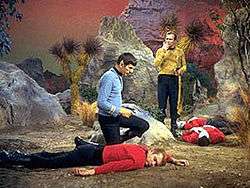Redshirt (stock character)
A "redshirt" is a stock character in fiction who dies soon after being introduced. The term originates from the original Star Trek (NBC, 1966–69) television series in which the red-shirted security personnel frequently die during episodes.[1] Redshirt deaths are often used to dramatize the potential peril that the main characters face.

Origin
In Star Trek, red-uniformed security officers and engineers who accompany the main characters on landing parties often suffer quick deaths.[2] The first instance of what now is an established trope can be seen in the episode "What Are Little Girls Made Of?" (1966).[3]
Of the 59 crew members killed in the series, 43 (73%) were wearing red shirts.[4] The Star Trek: Deep Space Nine book Legends of the Ferengi says Starfleet security personnel "rarely survive beyond the second act break".[5] An episode of Star Trek: Deep Space Nine titled "Valiant" (1998) also references red as a sort of bad luck omen, in which the plot centers around a group of cadets calling themselves "Red Squad", almost all of whom die in the episode. [6] The cinematic reboot of the franchise features a character named Olson (portrayed by Greg Ellis) who dies early on during a mission; he wears a red uniform in homage to the trope from the original series.[7]
Usage
In other media, the term "redshirt" and images of characters wearing red shirts has come to represent disposable characters destined for suffering or death.[8][9]
The trope, and its particular usage in Star Trek, has been parodied and deconstructed in other media. Parodies include Galaxy Quest (1999), a comedy about actors from a defunct science-fiction television series serving on a real starship, which includes an actor who is terrified that he's going to die because his only appearance in the show was as an unnamed character who was killed early in the episode.[10] Redshirts is a novel by John Scalzi that satirizes the trope, as does the PC game Redshirt.[11]
See also
References
- Bly, Robert W. (1996). Why You Should Never Beam Down in a Red Shirt: And 749 More Answers to Questions About Star Trek. ISBN 0-06-273384-2.
- Itzkoff, David (14 May 2006). "On 'Lost,' the Castaway Who Stands Out Without Even Trying". The New York Times. Retrieved 14 February 2011.
- DeCandido, Keith (12 May 2015). "Star Trek The Original Series Rewatch: "What Are Little Girls Made Of?"". Tor.com. Tor Books. Retrieved 31 May 2015.
- Bailey, Matt (13 February 2007). "Analytics According to Captain Kirk". SiteLogic Online Marketing Consultants. Retrieved 11 January 2013.
- Behr, Ira Steven; Robert Hewitt Wolfe (1997). Legends of the Ferengi. ISBN 0-671-00728-9.
- Jermaine, H (30 January 2015). "The Star Trek Red Shirt: A Mysterious In-Show Omen?". Allposters.com Blog. Allposters. Archived from the original on 5 April 2019. Retrieved 30 January 2015.
- "To Boldly Go", Star Trek (DVD release) featurette
- Upside Down: Inverted Tropes in Storytelling edited by Monica Valentinelli, Jaym Gates
- The Nowhere Bible: Utopia, Dystopia, Science Fiction By Frauke Uhlenbruch, page 176
- "Galaxy Quest (1999) Movie Review". Beyond Hollywood. 7 November 2002. Archived from the original on 3 October 2012. Retrieved 14 February 2011.
- "Redshirt on GOG.com". www.gog.com.
